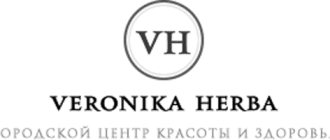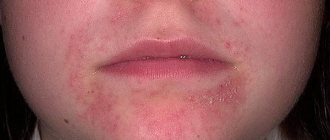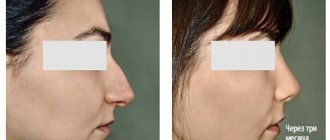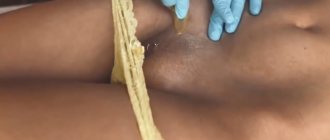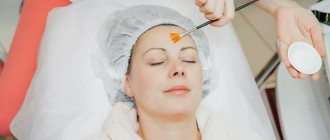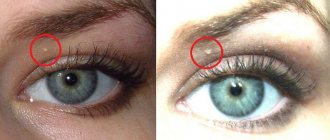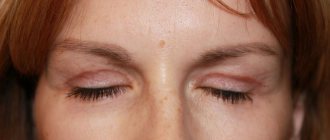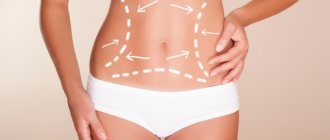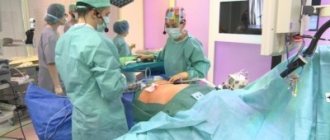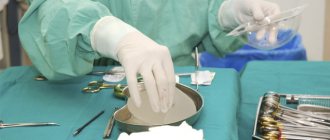Colloid scar or keloid is a defect of the epidermis, which is manifested by the proliferation of connective tissue and the formation of a convex dense scar.
Keloids usually appear some time after injury to the skin and subcutaneous tissue. They increase in size and extend beyond the damaged area. The peculiarity of the scar is that it gradually penetrates into nearby tissues and cannot resolve spontaneously.
The overgrown connective tissue is rich in blood vessels, so a keloid usually, unlike ordinary scars, has a flesh-colored, reddish or brown color.
It has a heterogeneous structure and irregular shape. Often colloidal scars manifest themselves as itching, throbbing or pain. In especially severe cases, the keloid can be so large that it looks like a tumor.
Classification
Colloidal scars are divided into two main groups: true and secondary or false.
The first ones are formed without any mechanical impact on the skin. In most cases, for unknown reasons, they are located on the back, in the chest area, on the earlobes and neck. Scars rise 5-7 mm above the surface of the epidermis.
They are benign, smooth, painless and insensitive. During laboratory studies of true keloids, specialists find many collagen fibers in the collected material.
Secondary scars are formed as a result of injuries and thermal or chemical burns of the skin and subcutaneous tissue. In some cases, a keloid forms at the site of a boil, trophic ulcer or stoma.
Keloids are also classified by age. There are recently formed and old scars. Young scars have a bright color and a smooth glossy surface. Old keloids are distinguished by an abundance of connective tissue nodes, roughness and pale color. 5-6 years after the appearance of scars, they stop increasing in size.
Attention! It is necessary to distinguish a keloid from other skin neoplasms. If the emerging growth is soft, quickly increases and is accompanied by swelling of nearby tissues, then there is reason to suspect the development of tumor processes.
Reasons for appearance
To date, it has not been possible to identify the exact causes that cause the appearance of colloidal scars. It was possible to establish that when the normal regeneration process is disrupted, pathological fusion of damaged tissue begins.
Healing of wound surfaces is a long and complex process in which, in addition to the skin, the immune, circulatory and lymphatic systems are involved, so it is very important to choose an ointment that will help quickly heal wounds.
In a healthy person, recovery from a minor injury takes about 7 days; a major burn or laceration can take about a year to heal. During regeneration, a flat scar forms on the skin, which subsequently disappears. If at any stage the process of tissue restoration is disrupted, then the damaged surface begins to be covered not by a new layer of epidermis, but by connective tissue with a high collagen content. A colloidal scar is formed. It may continue to grow beyond the wound, even months or years after the wound has healed.
A characteristic feature of a keloid is the minimal relationship between the size of the scar and the severity of the initial injury. Often, scars form at the site of minor scratches or abrasions, injections, acne, or insect bites. In a small percentage of people, keloids form on healthy skin for unknown reasons.
In this case, scars most often form on inactive areas of the body:
- In the navel area;
- On the chest and in the collarbone area;
- Behind the ears and on the earlobes;
- At the base of the neck;
- On the shoulders and in the area of the shoulder blades.
Other cosmetic procedures
Some clinics may offer other procedures that can get rid of the problem in question. These include:
- Fractional photothermolysis . This is a laser procedure that differs from the usual one in that it affects the skin not with a single beam/spot, but with scattering rays. Fractional photothermolysis allows you to solve the problem of not only scars, but also other consequences of acne and blackheads - increased pigmentation, too open pores.
Typically, a course of therapy with this method is 5 procedures, between which there should be a gap of 10 days. Rehabilitation is 3 days.
- Dermabrasion . This is a mechanical procedure that involves applying special brushes to the surface of the skin. By friction, the scar tissue is abraded, the scars are leveled into the same plane as the cover and become less noticeable. Dermabrasion is not one of the most effective procedures, but it helps solve the problem of “fresh” acne and blackheads.
- Ozone therapy . Medical ozone is injected under the skin of the face, which accelerates the healing of wounds and relieves inflammation. It will take 5 - 6 procedures, in some cases this number can increase to 10 - 15. In any case, ozone therapy requires long-term use and additional correction.
Symptoms and diagnosis
A keloid is a rough growth on the skin. Its dimensions can vary from a few millimeters to 30-40 centimeters or more. Due to the abundance of blood vessels, the scar differs in color from the surrounding epidermis. It is easy to diagnose keloid due to a number of characteristic symptoms:
- Red or brown color of the scar. The skin around it may be hyperemic due to the abundance of capillaries;
- Unlike a regular scar, a keloid does not lose sensitivity; pressing on it may be accompanied by pain;
- Itching and throbbing in the area of large scars.
Symptoms accompanied by physical discomfort in most cases bother the patient during the first 11-15 months from the onset of the keloid.
After this period ends, the scar, as a rule, enters an inactive stage. It gradually stops increasing in size, turns pale and loses pain. 1-2 years after formation, the keloid takes on the appearance of a rough, irregularly shaped scar.
How to remove scars and scars using mesotherapy
This type of cosmetic procedure involves injections of vitamins, amino acids and other substances. The essence of the method: the mesotherapy drug fills any “gaps/pits/cracks” in the epidermis, which causes visual smoothing of the surface of the skin. At the same time as this “hiding”, the active substances of the drug have a beneficial effect on the condition of the skin - they saturate it with vitamins, make it firmer and more elastic, and correct the color.
The advantage of mesotherapy in the fight against scars is obtaining a quick, almost instant result. But the effect will not last long - after a maximum of six months you will have to repeat the injections, which can be attributed to the disadvantages of the method.
Mesotherapy has a large number of contraindications, so before starting treatment for post-acne conditions, you need to consult a doctor. For example, if there are keloid scars, then the administration of corticosteroid drugs will be required, and they are prohibited for some diseases.
Who is at risk?
There are a number of factors that are prerequisites for the development of colloidal scars:
- Disorders of the reproductive and endocrine systems, hormonal imbalances in the body;
- Adolescence or old age;
- Suppression of the immune system: condition after organ or tissue transplantation, previous diseases, presence of the immunodeficiency virus;
- Pregnancy and lactation;
- Hereditary predisposition;
- Inflammatory processes, wound suppuration;
- Impaired blood supply and innervation of the tissues of the injured area, including as a result of ulcerative processes or burns.
Attention! Often colloidal scars form on the lip, earlobe, navel or wings of the nose as a result of punctures. Keloid in this area due to infection in the wound and subsequent inflammatory processes. If you decide to get a piercing, be sure to follow the rules of caring for it: treat it with antiseptic and anti-inflammatory ointment (zinc or boron), develop a puncture, wear items made of silver or medical steel.
Treatment
Since the reasons for the development of colloidal scars have not been established, there is no universal therapy. The specialist selects the treatment method individually depending on the manifestation of the pathology. Treatment includes conservative, that is, medication, therapy and surgical interventions.
Pharmacological treatment is used to eliminate keloids that formed less than 12 months ago. The following methods are used:
- Freezing raised scars and growths with liquid nitrogen - cryotherapy (CryoPharma, Wartner Cryo). Nitrogen affects the fluid in the tissues, which is found in large quantities in keloid formations. The disadvantage of this method is that cryotherapy can only remove the external manifestations of the scar. This method should be used as part of complex therapy;
- Injections of corticosteroids into the affected area (Prednisolone, Lorinden). This hormone leads to a local reduction in collagen production and reduces the inflammatory process;
- Immunomodulators (Interferon, Lykopid) are also injected intradermally, directly into the scar tissue. Injections are carried out once every two weeks for three months;
- Medicines for the prevention of tissue proliferation (Ronidaza, Longidaza, Lidaza). These are agents that are injected into the area next to the scar and prevent the keloid from affecting nearby tissue;
- Ointments against tissue scarring . Used as a preventive or auxiliary agent: “Kontraktubeks”, “Dermatix”, “Solcoseryl”.
Treatment of colloid scars also includes the use of physiotherapeutic procedures:
- Microwave electromagnetic effect on the affected area . Used to destabilize the water contained in the keloid tissue. It is recommended to use this method in conjunction with cryotherapy;
- Electrophoresis - administration of corticosteroids using electrical impulses;
- Magnetic wave therapy . Used exclusively as a preventative measure to stimulate rapid wound healing. It is used to treat patients with a hereditary predisposition to the formation of colloidal scars, weakened immunity and large wounds.
5-6 months after the formation of a keloid, cosmetic procedures can be carried out aimed at eliminating the effects of skin scarring:
- Laser therapy to remove small connective tissue nodes;
- Peels and scrubs to smooth the skin;
- Darsonvalization.
How to remove colloidal scar?
You can get rid of the scar using cryotherapy or surgery. In the first case, the drug is applied to the growth for a long time, after which the keloid is removed layer by layer. To completely eliminate it, 5 to 15 procedures are required.
Surgery involves complete excision of the overgrown connective tissue. Stitches are placed on the wound. If the scar was large, then skin grafting is recommended to prevent re-formation of the keloid.
Attention! After surgical removal of a keloid, there is a high risk of scar recurrence. Therefore, after surgery it is necessary to carry out physiotherapeutic and drug treatment.
It is worth considering that patients with true keloids are contraindicated for any surgical or injection treatment methods, as they can lead to the formation of new scars.
Surgeon E.I. Karpova talks about the dangers of aggressive therapeutic methods for people with primary colloid scars.
Treatment with traditional methods
Along with cosmetic procedures, medications and physiotherapy, traditional medicine recipes can be used to get rid of keloids.
Lemon juice is used to treat various skin pathologies, including colloid scars. They should be gently applied to the affected area and left for 30 minutes. Afterwards, rinse off the juice with warm water. The procedure should be carried out every day for 1-2 months.
Another effective remedy for improving blood and lymph circulation in the keloid area is a collection of chamomile, yarrow and nettle.
Herbs have an anti-inflammatory and restorative effect.
You need to mix a tablespoon of each plant and pour 0.5 liters of boiling water. After 1-2 hours, dip a clean gauze bandage into the infusion, apply it to the keloid and leave for 1.5-2 hours. Treatment should be carried out within 60 days.
To moisturize the skin and improve blood microcirculation in the capillaries of the scar, you can apply honey to the affected area daily and massage for 10-15 minutes.
Attention! The use of traditional methods of combating keloids should be carried out in combination with the use of traditional medicine methods.
Which peeling is better
In general, the peeling procedure is considered one of the most effective in the process of eliminating scars and acne scars. Cosmetologists know several types of such procedures, but if we consider them specifically in relation to the post-acne condition, it is worth highlighting the following:
- Deep phenolic peeling . This is a rather painful and aggressive procedure; phenol acts not only on the surface of the skin, but also penetrates into the deeper layers of the dermis. To visually hide the presence of scars, only 1 procedure is required. Rehabilitation will last 2 weeks, but this method can even get rid of deep keloid scars.
Disadvantages include soreness and increased pigmentation of the skin during the recovery period.
- Medium chemical peeling . The procedure is carried out using salicylic, trichloroacetic or glycolic acids. These substances actively exfoliate the already pathologically altered epidermis, while simultaneously having a stimulating effect on the regenerative abilities of the body. As a result, the connective tissue is replaced by a healthy, normal epidermis.
To get rid of scars, you will need to undergo at least 5 procedures with an interval of 10 - 14 days.
Stages of scar formation
Scar formation can last from several weeks to 1-1.5 years. It occurs in three main stages:
- Epithelization is the initial stage. Over the course of about two weeks, the area of skin thickens, becomes pinkish and slightly swollen, and acquires a pale pink color;
- Enlargement - the keloid begins to rise above the surface of the endometrium and acquires a brownish or bluish tint. This period lasts about a month;
- Induration - the keloid becomes rough to the touch, dense nodes of connective tissue can form in it.
As the scar grows, each new affected area of skin goes through these phases of keloid formation.
Why is a keloid dangerous?
A colloidal scar is not dangerous to human life and health, but it can cause a lot of discomfort and significantly reduce the quality of life. In severe cases, the keloid grows quickly, occupying large areas of the body, and often recurs. When it is damaged, bleeding develops, since there are many blood vessels in the scar. In people with weakened immune systems, an infection that gets into the keloid tissue can cause an inflammatory process.
Particular discomfort is caused by keloids formed in women as a result of cuts and tears in the perineum during childbirth. This growth causes quite severe pain and leads to disruption of sexual life. Therefore, if a woman is prone to the appearance of scars during pregnancy, she should regularly massage the perineum, and then resort to magnetic wave therapy procedures to prevent keloids.
Laser removal of acne effects
This method of dealing with scars and scars after acne and acne is considered the most effective; it can solve the problem of even hypertrophic “marks”. The laser burns scar tissue and activates the regeneration of epidermal cells.
To obtain the desired result, you will need to do 3 - 5 procedures with an interval of 60 - 90 days. A more precise amount of laser exposure will be determined by a specialist, since much depends on the “age” of the scar, the level of elasticity of the skin and the general health of the patient.
Laser removal of acne is a painful procedure and is therefore performed under local anesthesia. If the pain threshold is too low, the patient will be offered general anesthesia. The rehabilitation time after each treatment is at least 2 weeks, but it is possible to get rid of even “ancient” scars.
Prevention
Preventive measures to avoid the appearance of a colloid scar:
- Do not scratch or injure the scar formed at the wound site;
- Use special postoperative bandages made of compression knitwear;
- Treat injured skin with anti-scarring agents: “Sledotsit”, “Kontraktubeks”, “Rescuer”.
- If you have previously developed keloids, then avoid piercings, tattoos and injection cosmetic procedures.
